【第八十一回目】
駒形どぜう:江戸情緒とともに味わう「どぜう」、「くじら」
Komakata Dozeu: Enjoy loach and whale along with the feel of the Edo Period
Komakata Dozeu: Enjoy loach and whale along with the feel of the Edo Period
| 浅草寺の雷門から南に歩いて5分。セインさん、今日お訪ねするのは「駒形どぜう」です。創業は1801年。江戸時代から200年を超えて愛され続けているどじょう料理の店ですよ。 Today we’re going to visit Komakata Dozeu, just a five-minute walk south from Sensouji’s Kaminarimon. Established in 1801, this is a loach restaurant that has been patronized for over 200 years since the Edo Period. |
|
| 建物がかっこいい! すばらしいですね。 The building looks so amazing! It’s wonderful. |
|
| 江戸時代の代表的な商家の造りだそうです。2階に窓がないのは、大名行列を見下ろさないように、ということらしいですよ。 This is a typical merchant-house construction style of the Edo period. The building was purposefully built with no windows on the second floor so that commoners wouldn’t be able to look down on feudal lords and other aristocrats traveling on the road in front of the house. |
|
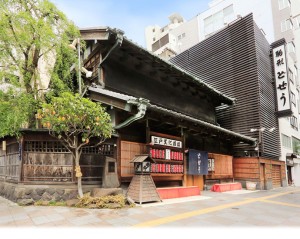 駒形どぜう浅草本店 外観 駒形どぜう浅草本店 外観[Photo: Komakata Dozeu Asakusa, exterior] |
|
| (渡辺) | こんにちはセインさん、コンシェルジュさん。駒形どぜう7代目の渡辺隆史です。 まずは、どうぞ店内へ。 Watanabe: Hello. I’m Takashi Watanabe, the 7th generation owner of Komakata Dozeu. Come on in. |
| うわー、1階は広いお座敷になっているんですね。お客さんの楽しそうな声やお店の人の威勢のよい声、それに料理やお酒の匂いが一緒になって、雰囲気最高! 江戸時代にタイムスリップしたようです。 Wow, the first floor is a large Japanese-style seating area. You can hear the customers enjoying themselves and the restaurant staff calling out, along with the smell of food and drink. It’s a great atmosphere! It’s like going back in time to the Edo period. |
|
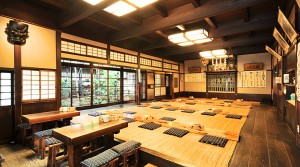 入れ込み座敷 入れ込み座敷[Photo: Japanese style seating] |
|
| (渡辺) | 浅草は、江戸の大火で焼け、大正末期の関東大震災で焼け、戦争でも焼けましたので、この店も戦後に建てなおしたものですが、江戸の庶民の味を楽しんでいただくのですから、江戸の風情も味わっていただきたいと……。 Watanabe: Asakusa was destroyed by fire over and over, in the great fire of Edo, the Great Kanto Earthquake in 1923, and again during WWII, so even though this is a post-war building, but we wanted people to enjoy the flavors that commoners of the Edo period did, as well as its atmosphere. |
| ビルに建て直したら何倍もお客様が入ったでしょうけれど、この店のご主人には代々、そういう強いポリシーが受け継がれているんですね。それにしても、この雰囲気は他では味わえませんね。 お座敷に長く置かれている板が、テーブル替わりなのですか? In this location, a large building would have accommodated a lot more customers, but the owners of the restaurant have handed down strong traditions from generation to generation. And so even today, you can enjoy an experience available nowhere else. Are those long boards in the seating area used for tables? |
|
| (渡辺) | はい。この上に料理が運ばれてきます。「かな板」と呼んでいるんですが、戦前までは、この板に銅板が張られていたんです。それで、銅板が無くなった今も「かな板」と呼んでいるんです。 Yes, we put food on them. They’re called kana-ita (metal boards) because they used to have copper panels on top until the pre-war. Now the copper panels are gone, but we still call them kana-ita. |
| (笑)。 では、早速、名物の「どぜうなべ」と「どぜう汁」を注文してみましょう。 Well, let’s go ahead and order the specialty loach nabe and loach soup. |
|
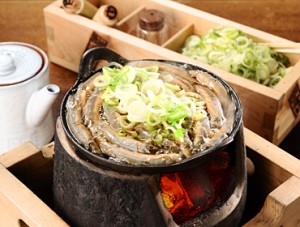 どぜうなべ どぜうなべ[Photo: Loach nabe] |
|
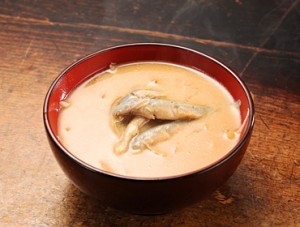 どぜう汁 どぜう汁[Photo: Loach soup] |
|
| 小さくて浅くて、変わった鍋ですね。そこに、どじょうがぎっしり。壮観です! This is an unusual small and shallow cast iron pot, and it’s filled with loach. What a sight! |
|
| (渡辺) | 鍋が浅いので、すぐに沸いてきますよ。ぐつぐつと軽く煮込めば出来上がり。ねぎをたっぷりのせてお召し上がりください。 Watanabe: Because the pot is shallow, it boils quickly. You’ll know it’s finished when it starts boiling a little. Top it with plenty of spring onion before you eat it. |
| おいしい。臭みもないし、骨もまったく気にならない! なぜですか。 Delicious. There’s no smell, and the bones are so soft. Why is that? |
|
| (渡辺) | どじょうを下ごしらえしてあるからです。生きたどじょうをお酒に浸けて酔わせたあと、味噌汁で煮込んであるんです。そのどじょうを鍋に並べて、割り下で煮込みながら召し上がっていただくという趣向です。 Watanabe: It’s because the loach are prepared in advance. We put a live loach in alcohol to intoxicate it, and then we boil it in miso soup. Then we arrange the loaches in the pot and have the customer eat while boiling them in broth. |
| 実は、とても手のかかった料理なんですね。 So, a lot of work goes into it. |
|
| (渡辺) | 下ごしらえの味噌汁に使っている江戸味噌は、東都のれん会のお仲間「ちくま味噌」さんのものです。麹の割合が多いので、普通の味噌のようにしょっぱくないんです。 Watanabe: The miso soup we use to prepare them in is Edo miso, from a fellow Toto Norenkai member, Chikuma Miso. It contains a higher proportion of koji, so it’s not as salty as regular miso. |
| どぜう汁も、おいしいです。白いご飯がすすんでしまう。 The loach soup is delicious too. It tastes really great with rice. |
|
| (渡辺) | どじょうは、江戸時代にはファストフードでした。江戸近郊の農家の人たちが朝採りの野菜をどっさりかついで江戸に入ってきて、まずは「どぜう汁」で朝ご飯。仕事を終えた帰り道、また寄ってくれて「どぜうなべ」。ふところにお金が少しある日には、お酒を1本つけたかもしれません……。 Watanabe: Loach were kind of like the fast food of the Edo period. When farmers came to Edo with their vegetables harvested in the morning, first they had loach soup for breakfast. After selling their vegetables and before heading home, they’d come again for loach nabe. If they had some pocket change, they might also order a bottle of sake. |
| ドラマティックですね! 実は、正直言って、どじょう料理がこんなにおいしいとは思っていなかったんですが、いまは、どじょうが江戸の人にも現代の人にも愛されている理由が納得できます。今日もお客様でいっぱいですが、1日に、どれくらいのどじょうが食べられているんですか? That’s quite an image! To be honest, I never imagined loach would taste this delicious, but now I understand the reason why both Edo people and modern day people love it. The restaurant is full of customers today. How many loach are eaten here every day? |
|
| (渡辺) | 50~60キロ、4万匹くらいでしょうか。休日は、もう少し多くなります。 Watanabe: Fifty to sixty kilograms, so that’s around 40,000 fish, more on holidays. |
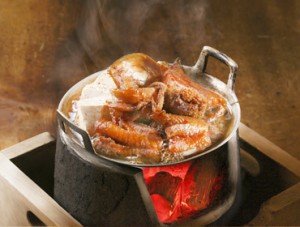 なまずなべ なまずなべ[Photo: Catfish nabe] |
|
| 次は、「くじらなべ」と、「なまずなべ」も食べてみましょう。 Let’s try the whale nabe and the catfish nabe next. |
|
| (渡辺) | くじら料理は、2代目が「どじょうは一番小さい魚だから、一番大きな魚も売ってみたい」と思い立って始めて以来の、うちのもう一つの名物です。「くじらなべ」は、くじらの脂身とゴボウを一緒に煮込みながら召し上がっていただく鍋。お好みで七味をどうぞ。 そして、「なまずなべ」は天然なまずを醤油たれでじっくり甘辛に煮込んであります。豆腐が煮えたら、山椒をひとふりして召し上がってください。七味唐辛子も山椒も、東都のれん会の「やげん堀 中島商店」のものです。 Watanabe: The whale dish is one of our well known dishes. It was introduced by the second generation owner who thought, Loach is the smallest fish, so let’s try selling the largest fish. The whale nabe has whale blubber boiled with burdock root. Add seven-spice blend as you like. The catfish nabe has fresh catfish boiled thoroughly in a salty-sweet soy sauce broth. When the tofu is boiled, add a dash of sansho pepper and eat it. Both the seven-spice blend and the sansho pepper are from the Toto Norenkai’s Yagenbori Nakajima Shoten. |
| どちらもおいしい! くじらはゴボウと、なまずは豆腐と合わせているのも、本当に良く考えられていますね。 Both of them are delicious! It’s really a good idea to pair the whale with burdock root and the catfish with tofu too. |
|
| この店は、料理はもちろん、建物やインテリア、そして従業員の皆さんの接客も溌剌としていてすばらしいですね。 The food here is wonderful of course, but the building and interior, and all the staff are so lively and wonderful too. |
|
| (渡辺) | ありがとうございます。この店は、お客様がお腹いっぱいになって、機嫌良くなって帰っていただく…そんな場所でありたいと思っているんです。ですから、毎月1回ですが、いろいろな分野の方を招いて従業員みんなで講習を受けたりもしています。 Watanabe: Thank you. I’d like this restaurant to be a place where the customers eat until they’re full and go home happy. So, once a month, we do things like inviting people from various fields to give the staff a lecture. |
| たとえば? For example? |
|
| (渡辺) | たとえば「どうしてお箸は左向きに置くのか」とか。 Watanabe: For example, we might learn why it’s proper to place chopsticks pointing to the left. |
| おもしろいですね。接客のハウツーではなくて、文化を学ぶんですね。 渡辺さん自身は、どんな勉強をしてきたんですか? That’s interesting. So the staff here can learn about the culture, and not just how to take care of customer. What kind of things have you studied? |
|
| (渡辺) | 小学校から大学までは一貫校でしたので、受験も知らず、勉強もあまりしないでいたんですが、そのあとアメリカ・メイン州の大学に行って2年間、心理学や数学、経営学を学びました。 Watanabe: From elementary school to university, I went to a single school organization, so I didn’t experience entrance exams and I didn’t study much either. But after that, I went to a university in Maine in the US for two years and studied psychology, math and business management. |
| アメリカの大学に行った甲斐はありましたか? Did you have a good experience there? |
|
| (渡辺) | ええ、勉強のやり方がわかりました。予習して、質問して、ちゃんと理解する、という単純なことですが。 Watanabe: Yes, I learned how to studyーstudying before a class, asking questions and then making sure you understood, simple things like that. |
| そう、それこそが大切なんですよね。 では最後に、7代目の当主として今、考えていらっしゃることを聞かせてください。 Yes, that’s important in itself. So before we finish up, as the seventh-generation owner, let us know what you are thinking about for the future. |
|
| (渡辺) | いま、2階の椅子席の部屋を明治時代の雰囲気にしたいと思って進めているところです。1階では江戸を、2階では明治を感じていただけたら楽しいかなと。また、この建物の隣に蔵があるんですが、その利用法なども考えているところです。 そして、どじょうをもっと多くの方に味わっていただくために、通販の展開も視野に入れています。 Watanabe: I want to make the room of chair seats on the second floor have more of a Meiji period atmosphere, so we’re moving forward with that. I think it would be great if guests could experience the Edo period on the first floor and the Meiji period on the second floor. We have a storehouse next to the building, so I’m thinking about how to use that. I want more people to try loach, so we’re working on a mail-order system. |
| その情熱が、この店を明るく活気づかせているんですね。 今日は江戸の雰囲気を、お腹いっぱい味わえました。おいしかったー。 It’s clear that your strong passion comes through in the way you operate the restaurant. Thank you for giving us a taste of the Edo period. It was delicious! |
|
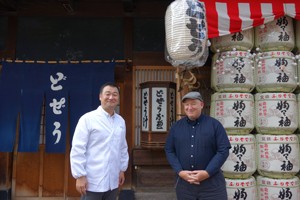 記念撮影 記念撮影[Photo: Commemorative photo] |
|
| 駒形どぜうホームページはコチラ | |
| (文)太田美代 (英訳)デイビッド・A・セイン |
 1959年、米国生まれ。証券会社勤務を経て来日し、翻訳・通訳など多岐にわたって活躍。豊富な教授経験を生かし、数多くの英語関係書籍を執筆。近著に『日本人のチョットへんな英語』(アスコム)、『超入門シャドーイング』(主婦の友社)、日本人が使いすぎる英語(PHP文庫)など多数。 下町の魅力に魅了され、自身が代表を務める英語関連のコンテンツ会社のエートゥーゼットのオフィスを根津に構えている。英会話本の執筆をしながら、東京・文京区根津と春日にあるエートゥーゼット英語学校の校長も務める。 http://www.smartenglish.co.jp/
1959年、米国生まれ。証券会社勤務を経て来日し、翻訳・通訳など多岐にわたって活躍。豊富な教授経験を生かし、数多くの英語関係書籍を執筆。近著に『日本人のチョットへんな英語』(アスコム)、『超入門シャドーイング』(主婦の友社)、日本人が使いすぎる英語(PHP文庫)など多数。 下町の魅力に魅了され、自身が代表を務める英語関連のコンテンツ会社のエートゥーゼットのオフィスを根津に構えている。英会話本の執筆をしながら、東京・文京区根津と春日にあるエートゥーゼット英語学校の校長も務める。 http://www.smartenglish.co.jp/







